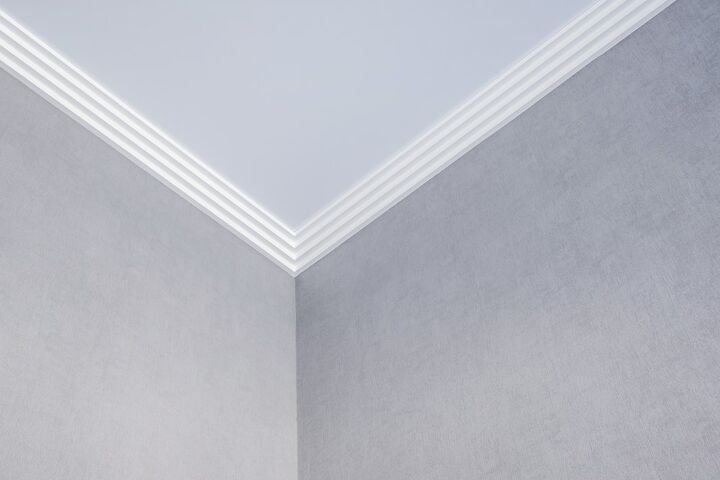What Is The Best Way To Hide An Uneven Ceiling? (Do This!)

Adding crown molding or a fresh color of paint transforms a room. You have a clear vision of how the room will look once the job is finished. As the work begins, you realize that you have uneven ceilings. Should you give up on your dream room, or is there a way to hide uneven ceilings?
Hide uneven ceiling lines with paint and crown molding. Fix a wavy ceiling by applying a layer of drywall mud to even out the surface. An uneven ceiling is a sign that the drywall was not measured correctly, or the house has settled. Waves in a ceiling indicate that the framing joists are not straight.
Let’s take a closer look at uneven ceiling lines and waves in ceiling, and learn about some simple ways to fix the problem.
Do You Need Wall and Ceiling Contractors?
Get free, zero-commitment quotes from pro contractors near you.

What Causes Uneven Ceilings?
There are two types of uneven ceilings. The first type of when the line between the wall and ceiling runs at a slight diagonal. The second type is when there are waves in the ceiling. Let’s look at each problem individually.
Uneven Ceiling Line
An uneven ceiling line is caused by slight mismeasurements of the drywall or normal settling of the house. Ideally the drywall should have a perfect 90° angle at the point where the wall and ceiling meet. Construction projects rarely turn out perfect. As long as the drywall was installed within acceptable specifications, the quality of the work is acceptable. Settling is a normal process that happens very gradually.
A slightly slanted ceiling line is barely noticeable unless you measure the angle of the line. You only discover the problem when you paint the room or install molding.
Wavy Ceilings
The second type of an uneven ceiling is waves across the span of the ceiling. The waves are caused by uneven joists in the framing or water damage.
Are Uneven Ceilings Dangerous?
Uneven ceiling lines are not dangerous. Waves in the ceiling are another matter. Uneven joists can be harmless if the problem originated during construction. If the joists are damaged, you have a roofing problem on your hands.
Wavy Ceilings and Your Roof
Water damage breaks down the wooden joists that hold up the roof of your house. The waves indicate that the water reached the drywall, and the material is sagging. Have the roof inspected before you work on fixing the waves in your ceiling.
Ways to Hide an Uneven Ceiling
Hiding an uneven ceiling takes about one day. Uneven ceiling lines and wavy ceilings require two different approaches.
How to Hide Uneven Ceiling Lines
Hide uneven ceiling lines with paint or crown molding. Rather than fixing the uneven ceiling line, you are cleverly camouflaging it.
The trick with using paint to hide an uneven ceiling line is to use a darker color on the walls and a lighter color on the ceiling. Run the darker color into the ceiling or run the lighter color down the wall. Both methods work well, but the easiest is running the lighter color slightly down the wall. Start a chalk line at the end of the wall where the slant begins.
Use the level to mark a perfectly straight line to the other wall. Paint along the line using your ceiling color. If you prefer to run the wall paint into the ceiling, follow the same steps, but make the chalk line along the ceiling and paint with the wall color.
Crown molding is another great trick for hiding uneven ceiling lines. Use a chalk line to mark a straight line across the wall, as use this as the top line for each section of molding. Fill in the gaps between the molding and ceiling with caulk. Use a caulk that can be tinted to match the molding.
How to Fix a Wavy Ceiling
If your roof is in good shape, you are ready to start evening out the ceiling. Work in small sections, focusing on the areas where you notice the waves. Apply the drywall mud to the areas where the ceiling is slightly higher. Use just enough drywall mud to even out these areas with the rest of the ceiling.
Use a gentle touch and feather out the drywall mud to create an even texture across the ceiling. Let the mud dry overnight. Check the results, and apply mud where you can still see waves in the ceiling. Paint the entire ceiling to finish the job.
How to Hide an Uneven Ceiling When Tiling Walls
If you notice an uneven ceiling line when you are tiling walls, fill in the gap with caulk. Tint or paint the caulk the same color as the tile or ceiling.
Uneven Ceiling and Cabinets
An uneven ceiling line along the top cabinets of your kitchen present a unique challenge. Paint and crown molding don’t work as well because the reference line is the top of the cabinet. First, check that the cabinets are level. If the cabinets are not level, remove them from the wall, and reinstall them so they are level.
If the cabinets are level, spacer panels work well to camouflage the uneven ceiling. Cut the top of the panel at a slight diagonal to match the ceiling angle.
Related Questions
Why is my ceiling sagging?
A sagging ceiling indicates that there is damage to the frame of the house. Water damage is the most common reason why ceilings sag. Contact a professional to have your roof inspected and repaired.
What is the best paint to hide waves in the ceiling?
Flat latex is the best paint for hiding waves and other flaws in your ceiling. Darker colors absorb light, so they work better than lighter colors that reflect light. Semi-gloss and gloss also reflect light, and this accentuates the waves in your ceiling.
How do I fix an uneven ceiling fan?
Adjust the position of each blade. Each blade needs to be the same distance from the ceiling. Turn off the fan. Use a ladder to check that the screws on the blade are tight. Measure the distance from the ceiling to the edge of the blade. Keep the measuring tape in the same place and rotate the fan. Check the next blade. Bend the bracket at the end of the blade up or down to match the measurement of the first blade. Repeat this process for each blade of the fan.
What is the best way to apply drywall mud to a finished ceiling?
Cover the floor with plastic sheeting. Wear a mask. Clean the ceiling with a small brush and damp sponge, and use a clean towel to dry the ceiling.Mix a small amount of the mud in a pan using a drywall knife. Scrape the mud from the knife on the edge of the pan, and pick up a small amount of the mud, and press it onto the ceiling.Smooth out the mud using a back-and-forth motion. Keep the knife at a 30° angle. Place two fingers on top of the knife, and apply the mud with a firm, even pressure. Use long, consistent strokes. Scrape the knife against the edge of the pan to remove any excess mud. Feather the edges of the mud to blend in with the rest of the ceiling.
Can I paint over water damage on my ceiling?
Yes. As long as the ceiling isn’t sagging, you can paint over water damage stains on your ceiling. Before you do, though, have a professional check the roof. Also, check the drywall for damage. Apply a coat of primer to hide the stains, and paint the entire ceiling.
Do You Need Wall and Ceiling Contractors?
Get free, zero-commitment quotes from pro contractors near you.

What Did We Learn?
The two types of uneven ceilings are waves in ceilings and slightly diagonal angles at the meeting point of the wall and ceiling. Uneven ceiling lines are not cause for concern. The drywall was cut a little uneven when it was installed.
Hide uneven ceiling lines with paint or crown molding. Use a chalk line to mark a level line across the wall. Paint down the wall to the line with your ceiling color, or use the chalk line as the marker for the top of your crown molding. Fill in the space between the molding and ceiling with a caulk that is tint or paint the caulk to match your ceiling color.
Waves in the ceiling indicate that joists were installed a bit unevenly, or you may have some roof damage. Have the roof inspected and repaired. If the roof is in good shape, use drywall mud to even out the waves. Working in small sections, apply enough mud to fill in where the ceiling looks slightly higher. Feather the drywall mud for a smooth texture. Check the results from a distance as you work on each section. Let the drywall mud dry overnight. Finish the job by painting the entire ceiling.
If you have an uneven ceiling line along the top cabinets of your kitchen, check that the cabinets are level. Hide the uneven ceiling line above level cabinets with spacer panels.

Jennifer L. Eggerton loves being hands-on, whether it's with a home DIY project, making repairs, re-decorating a room, or keeping life organized. She enjoys helping people by sharing her knowledge, insights, and experiences, as well as her lessons learned. In addition to her work as a writer, Jennifer is a Jeep® overlander, self-published author, and nature photographer who loves being outdoors.
More by Jennifer Eggerton











![The 10 Best Table Saws - [2022 Reviews & Buyer's Guide]](https://cdn-fastly.upgradedhome.com/media/2023/07/31/9070645/the-10-best-table-saws-2022-reviews-buyer-s-guide.jpg?size=350x220)















